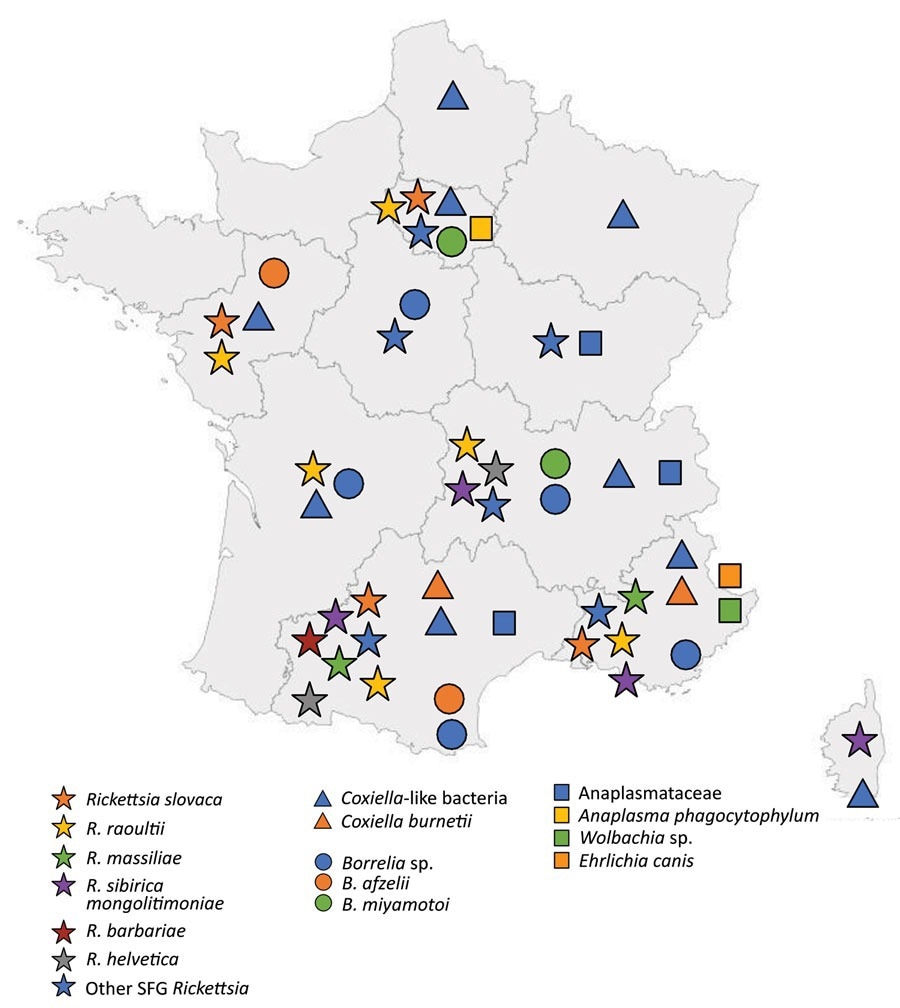In a recent study published in the journal Emerging Infectious Diseases, researchers analyzed ticks that bit humans between January 2014 and March 2021 in France for the presence of bacterial pathogens.
 Synopsis: Bacterial Agents Detected in 418 Ticks Removed from Humans during 2014–2021, France. Image Credit: Afanasiev Andrii / Shutterstock
Synopsis: Bacterial Agents Detected in 418 Ticks Removed from Humans during 2014–2021, France. Image Credit: Afanasiev Andrii / Shutterstock
Background
Ticks are an obligatory hematophagous type of arthropod vector that carry causative pathogens of zoonotic infections in humans, including pathogenic viruses, protozoa, and bacteria. Emerging tick-borne disease (TBD)-associated agents that infect humans include Rickettsia tamurae and Borrelia miyamotoi.
Ticks most commonly observed in human zoonotic infections in Europe include Dermacentor, Rhipicephalus, and Ixodes species. TBDs, such as tick-borne encephalitis, tularemia, and Crimean-Congo hemorrhagic fever, are TBDs, are under the European Centers for Disease Control and Prevention (European CDC) surveillance. TBD monitoring could aid in developing optimal preventive and therapeutic strategies.
About the study
In the present study, researchers analyzed ticks removed from human bites and bacterial pathogens carried by them at the Institut Hospitalo-Universitaire Méditerranée Infection (IHU-MI) of France, using morphological assessments, matrix-assisted laser desorption/ionization time-of-flight mass spectrometry (MALDI-TOF MS), and serological assessments.
Protein profiling was performed, and the protein spectra of the samples were compared to arthropod spectra uploaded in the MALDI-TOF MS database. To identify ticks by molecular techniques, tick deoxyribonucleic acid (DNA) was extracted, and the polymerase chain reaction (PCR)-amplified products of the 12S ribosomal ribonucleic acid (rRNA) gene were subjected to Sanger sequencing.
The uninfected and laboratory-nurtured Rhipicephalus sanguineus tick DNA was used as a control for the analysis. Tick screening was performed for Rickettsia species, Bartonella species, Borrelia species, Coxiella burnetii, Francisella tularensis, Anaplasmataceae, and Coxiella-like bacterial organisms. Pathogenic bacteria were detected using regular or real-time PCR. In addition, epidemiological and clinical data were obtained from humans bitten by ticks, including age, sex, date, symptoms, treatment, and geographical origin of tick exposure.
Acute-phase sera and, whenever possible, convalescent sera obtained after >2.0 weeks were assessed by indirect immunofluorescence (IIF) assays for spotted fever-causing pathogens, including Rickettsia species, Bartonella quintana species, B. henselae species, Borrelia species, C. burnetiid phase 1.0 and phase 2.0, Anaplasma phagocytophilum, and F. tularensis.
Enzyme-linked immunosorbent assays (ELISA) were performed to detect Borrelia burgdorferi, followed by Western blot analysis in cases of positive ELISA results. Immunoglobulin G (IgG) and IgM titers were assessed. In addition to serological samples, skin biopsies and eschar swabs were examined for tick-borne pathogenic organisms for a few patients.
Results
In total, 418 ticks, obtained from 359 humans, were analyzed, and each patient had one to 16 tick bites. The team identified ticks such as Ixodes (47%, n=197), 136 (33%) Dermacentor (33%, n=136), Rhipicephalus (16%, n=67), Hyalomma (2.0%, among eight patients), Amblyomma (1.0%, among six patients), Argas (0.5%, among two patients), and Haemaphysalis (0.5%, among two patients).

Geographic origin of ticks and identification of tickborne bacteria in study of bacterial agents detected in 418 ticks removed from humans during 2014–2021, France. Symbols indicate tick species and tickborne bacteria identified from locations in metropolitan France, including Corsica. Ticks were sent to the Institut Hospitalo-Universitaire Méditerranée Infection in Marseille, France, and identified by using matrix-assisted laser desorption ionization time-of-flight mass spectrometry. Bacteria carried by the ticks were isolated and identified by PCR or serologic methods at the institute. Of the ticks evaluated, 387 were from metropolitan France; 3 from Guadeloupe, a territory of France in the West Indies; and 28 from other countries.
Bacterial DNA was detected in 58% (n=241) of the ticks, and the most commonly observed ones were Rickettsia raoultii (17.0%) and R. slovaca (13.0%) in Dermacentor ticks, and R. massiliae (16%) and Borrelia species (9.0%) in Rhipicephalus ticks. Of the 359 patients bitten by ticks, 62% (n=222) were female, with ages ranging between 1.0 months and 86.0 years.
Of 217 patients with available clinical data, 49% (n=107) had symptoms, of which the most frequent ones were local erythema, inoculation eschar, lymphadenopathy, fever, and cutaneous rash, observed among 37, 33, 27, 17, and 15 patients, respectively. TBDs were diagnosed among 26 patients, nine of whom suffered from Lyme borreliosis, and 15 developed cervical or cephalic inoculation eschar corresponding to the scalp eschar and neck lymphadenopathy syndrome (SENLAT).
All humans with TBD diagnoses were bitten by ticks carrying bacterial pathogens. The most commonly prescribed antimicrobials were doxycycline, azithromycin, and amoxicillin, administered to 26, 21, and 18 patients, respectively. Other antimicrobials administered include vancomycin, pristinamycin, amoxicillin, and clavulanic acid combination, and fusidic acid was prescribed for topical application.
Bites of Ixodes species, Rhipicephalus species, and Dermacentor species were more frequently detected in summer, in the last few days of the spring season, and during the autumn and spring seasons, respectively. In metropolitan regions of France, Ixodes species were most frequent, except for the increased prevalence of Dermacentor species in South France, along with Hyalomma species ticks. Rhipicephalus species mainly originated from Southeast France. The Amblyomma species’ ticks primarily originated from Guadeloupe, and 28 of the ticks identified originated from other nations.
Overall, the study findings showed tick and pathogenic bacteria identification using molecular techniques, MALDI-TOF mass spectrometry, and morphological assessments. Rapid identification of ticks, and pathogenic microbes carried by ticks, can guide treatment strategies and enable the provision of the most appropriate care to affected individuals. Patients residing in TBD endemic regions may benefit from preventive antibiotic therapy. The study findings also highlighted MALDI-TOF mass spectrometry as robust, reproductive, reliable, time-effective, and cost-effective for tick identification in diagnostic setups.